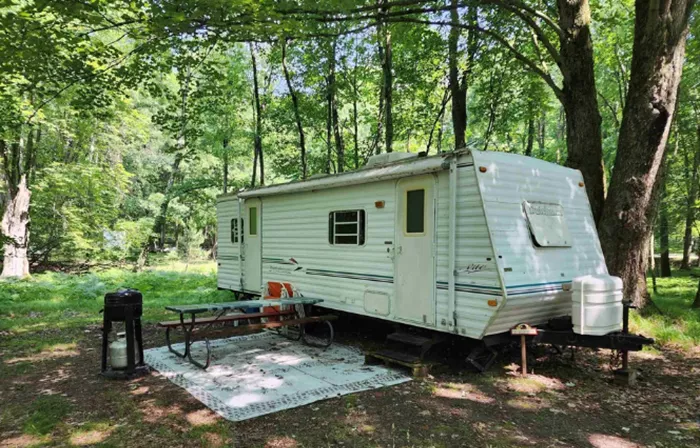Camping is a wonderful way to connect with nature, but it also comes with practical challenges. One of the most common concerns for campers is figuring out where to go to the bathroom. Whether you’re in a campsite with facilities or deep in the wilderness, managing this aspect of camping is essential for both comfort and environmental responsibility.
Types of Bathroom Options While Camping
Campground Restrooms
In developed campgrounds, you’ll often find restrooms or toilet facilities. These can range from modern flush toilets to more basic vault toilets.
Flush Toilets: Found in well-maintained campgrounds, these offer a home-like experience with running water.
Vault Toilets: These are non-flush toilets that consist of a sealed underground tank. They’re low-maintenance but can sometimes have a strong odor.
Portable Toilets: Some campgrounds provide portable toilet setups during busy seasons.
Using Nature as Your Restroom
For campers in remote areas, nature often becomes the bathroom. There are guidelines to follow to minimize environmental impact:
Digging a Cat Hole: This is a small hole dug in the ground for waste.
- Dig a hole 6-8 inches deep and at least 200 feet away from water sources.
- Cover the hole with soil after use.
Natural Toilets: Use natural materials like large rocks, logs, or bushes for privacy.
Portable Camping Toilets
For added convenience, many campers bring portable toilets. These compact devices mimic regular toilets and are easy to use.
Bag-Based Systems: These toilets use waste collection bags that can be disposed of later.
Chemical Toilets: These break down waste using chemicals, reducing odor and making disposal easier.
Choosing the Right Spot
Distance from Water Sources
Always ensure you are at least 200 feet (about 70 steps) away from lakes, rivers, or streams. This prevents contamination of drinking water and protects aquatic ecosystems.
Privacy
Look for natural barriers such as bushes, trees, or boulders to create a private area. This ensures comfort for you and respect for others in your group.
Avoid Trails and Campsites
Never go to the bathroom near hiking trails or camping areas. This maintains cleanliness and avoids unpleasant encounters for other campers.
Essential Gear for Bathroom Needs
Trowel
A lightweight, sturdy trowel is perfect for digging cat holes. Some are even marked with depth measurements to help you dig the right size.
Biodegradable Toilet Paper
Always choose biodegradable toilet paper to minimize your environmental impact. Bring a resealable bag to pack out used paper if required.
Hand Sanitizer or Soap
Hygiene is critical, even in the wilderness. Hand sanitizer or biodegradable soap helps you stay clean after bathroom use.
Waste Disposal Bags
Pack-out systems require special bags designed to seal waste securely. Some bags include chemicals to neutralize odor and begin breaking down waste.
Tips for Women and Families
Women-Specific Tools
For women, devices like female urination devices (FUDs) make it easier to pee while standing. They are especially useful in areas without privacy.
Helping Children
If camping with children, explain the process and help them feel comfortable. Bring child-sized bags or portable toilets to make the experience easier.
What to Do with Toilet Paper?
Packing Out vs. Burying
The Leave No Trace principle encourages packing out toilet paper. Used toilet paper can be stored in a resealable plastic bag.
In some areas, you can bury toilet paper in the cat hole. However, this is only acceptable if local regulations permit it.
Natural Alternatives
If you run out of toilet paper, natural options include leaves, smooth stones, or snow. Ensure the material is non-toxic and won’t cause irritation.
When Campgrounds Have No Toilets
Improvised Setups
In the absence of formal facilities, you can create your own setup. Options include:
DIY Toilet Seat: Use a bucket with a toilet seat attachment.
Improvised Privacy Shelter: Hang a tarp or use a pop-up privacy tent.
Eco-Friendly Practices
Avoid Contaminating Water
Never go to the bathroom in or near water sources. Waste can carry harmful bacteria that impact wildlife and other campers.
Use Eco-Friendly Products
Biodegradable soaps and bags reduce your footprint and protect the environment.
Follow Local Rules
Always check the regulations for the area you’re visiting. Some parks have strict rules about waste disposal and may even require you to pack out all waste.
Managing Urine
Urine has less environmental impact than solid waste, but it still requires care.
- Go at least 200 feet away from water sources.
- Avoid peeing on plants, as the high nitrogen content in urine can damage them.
Handling Menstrual Hygiene
Camping during your period requires some preparation:
- Use menstrual cups or reusable pads to minimize waste.
- Bring resealable bags for packing out disposable products.
- Wash hands thoroughly after changing menstrual products.
Final Thoughts
Knowing where to go to the bathroom while camping is an essential skill. Whether you’re at a campground with facilities or deep in the wilderness, planning and preparation ensure a safe, hygienic, and environmentally friendly experience. Follow these tips to enjoy your trip while leaving no trace behind.
Related topics:
- Is K2 Base Camp Trek Safe?
- When Do 2024 Campers Come Out? A Comprehensive Guide
- Best Canvas Tent 2024: Top Picks for Outdoor Adventures


